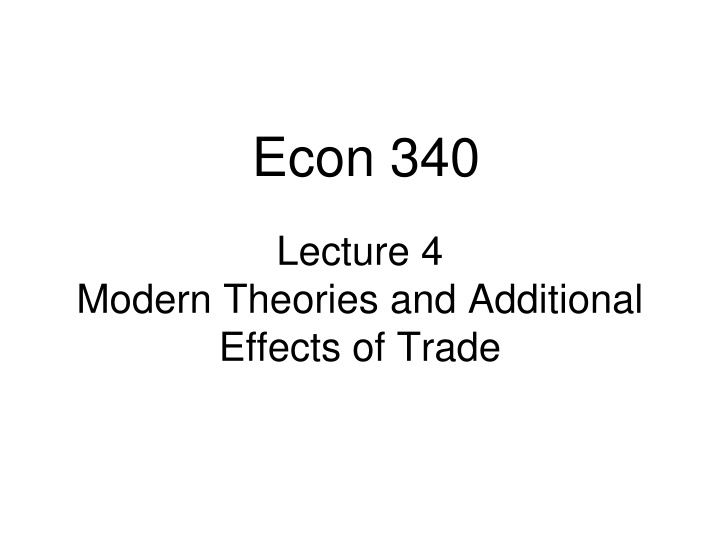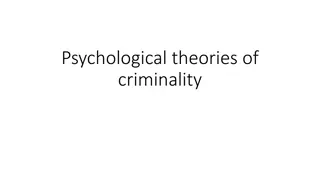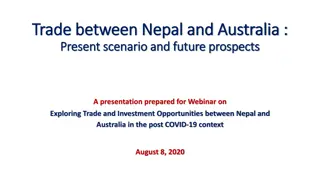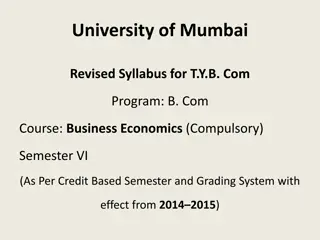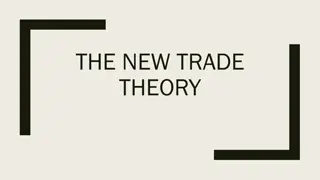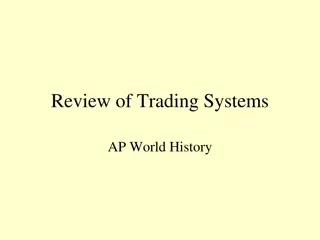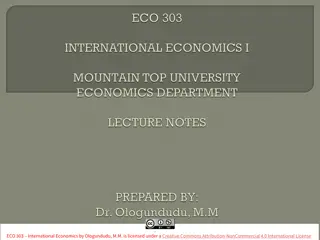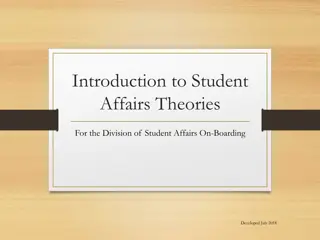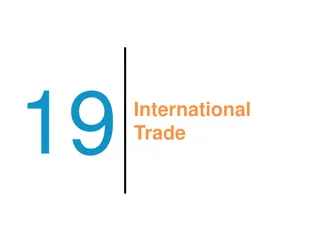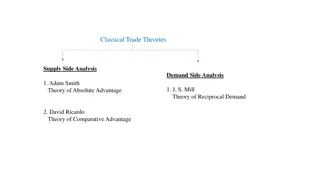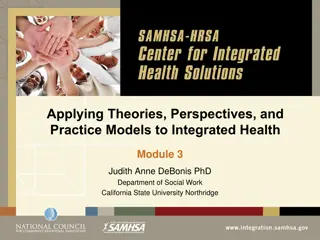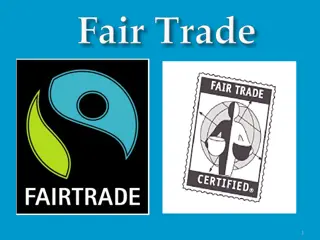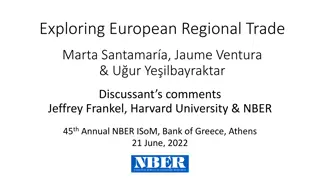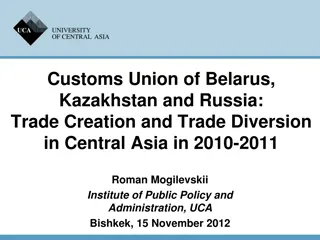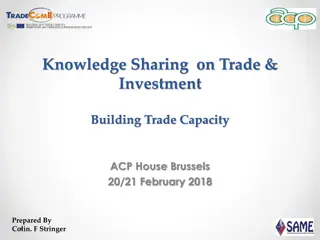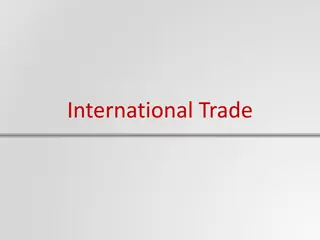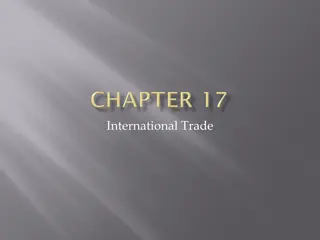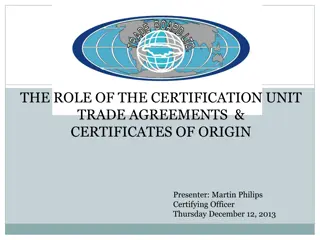Modern Theories and Effects of Trade
This content delves into modern theories and additional effects of trade, covering sources of comparative advantage, the Heckscher-Ohlin model, and impacts on production factors, prices, and more. Explore factors like technology, demand, and scale economies influencing international trade dynamics.
Download Presentation

Please find below an Image/Link to download the presentation.
The content on the website is provided AS IS for your information and personal use only. It may not be sold, licensed, or shared on other websites without obtaining consent from the author.If you encounter any issues during the download, it is possible that the publisher has removed the file from their server.
You are allowed to download the files provided on this website for personal or commercial use, subject to the condition that they are used lawfully. All files are the property of their respective owners.
The content on the website is provided AS IS for your information and personal use only. It may not be sold, licensed, or shared on other websites without obtaining consent from the author.
E N D
Presentation Transcript
Econ 340 Lecture 4 Modern Theories and Additional Effects of Trade
Outline Sources of Comparative Advantage The Heckscher-Ohlin Model Main Idea Intuition Does the Theory Work? Effects of Trade Changes in Production Factor Price Equalization The New Trade Theory Assumptions Implications The New New Trade Theory Lecture 4: Modern Theories 2
Sources of Comparative Advantage What determines comparative advantage? Answer: Many things Definition: Comparative Advantage is a low price for a good, in autarky, relative to other goods compared to other countries. Double comparison Lecture 4: Modern Theories 3
Sources of Comparative Advantage Factor Proportions This will be the most important We ll come back to it in a moment Lecture 4: Modern Theories 4
Sources of Comparative Advantage Technology This is associated with Ricardo and the Ricardian model we looked at last time Technological advantage exports Advantage may be eroded over time by Technology transfer to other countries Multinational companies that use technology abroad Technical progress that makes earlier innovations obsolete Lecture 4: Modern Theories 5
Sources of Comparative Advantage Demand High demand for a fixed available quantity leads to High price, leads to Comparative Disadvantage Thus imports Lecture 4: Modern Theories 6
Sources of Comparative Advantage Scale Economies (i.e., Increasing Returns to Scale) Definition: Average cost falls as output rises Leads to lower cost for large countries Problem: scale economies also lead to large firms, and therefore imperfect competition (We ll deal with this later today, under New Trade Theory ) Lecture 4: Modern Theories 7
Outline Sources of Comparative Advantage The Heckscher-Ohlin Model Main Idea Intuition Does the Theory Work? Effects of Trade Changes in Production Factor Price Equalization The New Trade Theory Assumptions Implications The New New Trade Theory Lecture 4: Modern Theories 8
The Heckscher-Ohlin Model The Factor Proportions Model Also called Heckscher-Ohlin Model Due to Eli Heckscher (1879-1952), Bertil Ohlin (1899-1979), and Paul Samuelson (1915-2009 ) Lecture 4: Modern Theories 9
The Heckscher-Ohlin Model The Factor Proportions Model Main idea: Comparative advantage is determined by Factor endowments of countries, together with Factor intensities of industries Lecture 4: Modern Theories 10
The Heckscher-Ohlin Model Two differences drive trade in H-O Model 1. Countries differ in endowments of factors 2. Industries differ in factor intensities Lecture 4: Modern Theories 11
The Heckscher-Ohlin Model Two differences drive trade in H-O Model 1. Countries differ in endowments of factors Labor Capital Land Skill (Human capital) Resources 2. Industries differ in factor intensities Lecture 4: Modern Theories 12
The Heckscher-Ohlin Model 1. Countries differ in endowments of factors 2. Industries differ in factor intensities Examples: Agriculture uses lots of land Textiles & apparel use lots of unskilled labor Autos use lots of capital Computers use lots of human capital Lecture 4: Modern Theories 13
The Heckscher-Ohlin Model Implication of #1 and #2: Heckscher-Ohlin Theorem: Countries have comparative advantage in, and therefore export, goods that use relatively intensively their relatively abundant factors Lecture 4: Modern Theories 14
The Heckscher-Ohlin Model Implication of #1 and #2: Heckscher-Ohlin Theorem: Countries have comparative advantage in, and therefore export, goods that use relatively intensively their relatively abundant factors Lecture 4: Modern Theories 15
The Heckscher-Ohlin Model Intuition Abundant factors are cheap (in autarky) Cheap factors produce cheap goods Hence comparative advantage Crucial for the model: Factors (labor, capital, etc.) are perfectly mobile within a country across industries Thus all labor in a country is paid the same wage wages, etc., do not differ by industry. Lecture 4: Modern Theories 16
The Heckscher-Ohlin Model Does the H-O Theory Work Empirically? Evidence against Leontief Scarce Factor Paradox In early 1950s, Wassily Leontief (1906-1999) measured capital (K) and labor (L) in US exports (X) and imports (M). Found: Paradox, since US was thought to have abundant capital US US K K X M L L X M exports imports More recent studies have been mixed. Lecture 4: Modern Theories 17
The Heckscher-Ohlin Model Does the H-O Theory Work? Evidence in favor US exports agricultural goods and high-tech goods, intensive users of our abundant land and human capital Developing countries export textiles and apparel, intensive in unskilled labor Most recent studies have found increasing evidence that trade patterns do depend on Factor proportions, as the H-O theory says, But also on differences in technology Conclusion: H-O theory is an important part of the story, But it is not the whole story Lecture 4: Modern Theories 18
Outline Sources of Comparative Advantage The Heckscher-Ohlin Model Main Idea Intuition Does the Theory Work? Effects of Trade Changes in Production Factor Price Equalization The New Trade Theory Assumptions Implications The New New Trade Theory Lecture 4: Modern Theories 19
Effects of Trade (according to H-O Theory) Trade causes: Production: of export good Factors (labor, capital, etc.) to move industries: toward export sector Industries expand, contract, or may disappear (as in Ricardian model) Factor demands: for abundant factor for scarce factor Factor prices: of abundant factor of scarce factor of import good Lecture 4: Modern Theories 20
Effects of Trade (according to H-O Theory) Two important implications for factor prices: Factor Price Equalization Trade causes prices of factors in different countries to move together, even to become equal across countries Stolper-Samuelson Theorem Real price (i.e., wage in terms of goods it can buy) of a country s abundant factor rises due to trade Real price (wage) of its scarce factor falls NOTE: This means that there are losers from trade: the owners of a country s scarce factor. (In the US, that is (unskilled) labor) Lecture 4: Modern Theories 21
Wolfgang Stolper and Paul Samuelson Lecture 4: Modern Theories 22
Effects of Trade (according to H-O Theory) Implications of the Stolper-Samuelson Theorem See Bivens If the Stolper-Samuelson Theory is right for the US, then labor loses from trade That s a lot of people, perhaps a majority of the population Though really it is only low-skilled labor that loses, which is fewer And it implies increased inequality True even more so with only the low-skilled being hurt Lecture 4: Modern Theories 23
Effects of Trade (according to H-O Theory) Implications of the Stolper-Samuelson Theorem What should we do about it? Bivens, though himself a critic of trade, does not say to restrict trade He advocates other policies to redistribute income toward low-wage workers large-scale social insurance programs universal health care stable pension income disability and life insurance lifetime of access to high-quality public education Lecture 4: Modern Theories 24
Clicker Question In the Heckscher-Ohlin Model, what would cause a country to import the capital- intensive good? a) The country is small b) The country is large c) The country has relatively little capital d) The country has relatively a lot of capital 25
Clicker Question If a country that is relatively labor-abundant opens to trade, what will happen to the real wage in the Heckscher-Ohlin Model? a) Rise b) Fall c) Remain unchanged d) It s not possible to tell 26
Outline Sources of Comparative Advantage The Heckscher-Ohlin Model Main Idea Intuition Does the Theory Work? Effects of Trade Changes in Production Factor Price Equalization The New Trade Theory Assumptions Implications The New New Trade Theory Lecture 4: Modern Theories 27
The New Trade Theory New Trade Theory Developed in the early 1980s Most prominent contributor was Paul Krugman, now a New York Times columnist Won Nobel Prize 2008 Lecture 4: Modern Theories 28
The New Trade Theory Assumptions of the New Trade Theory One or more of Increasing returns to scale Imperfect competition Monopoly (one seller) Oligopoly (few sellers) Monopolistic competition (many sellers, but each with some market power) Product differentiation None of these were allowed in the Ricardian and H-O Models Lecture 4: Modern Theories 29
The New Trade Theory Implications of the New Trade Theory 1. Countries may export the same good to each other 2. Countries may lose from trade 3. More and broader reasons for countries to gain from trade 4. New rationales for using policy to affect trade More on each of these Lecture 4: Modern Theories 30
The New Trade Theory 1. Countries may export the same good to each other This is called Intra-Industry Trade (IIT) Example: US both exports and imports cars Lecture 4: Modern Theories 31
The New Trade Theory 1. Countries may export the same good to each other This is called Intra-Industry Trade (IIT) Example: US both exports and imports cars Lecture 4: Modern Theories 32
The New Trade Theory Explanations for IIT Definitions of industry may be too large, and include Different, but similar, products Toyotas Fords Goods at different stages of processing Autos Auto parts Lecture 4: Modern Theories 33
The New Trade Theory Explanations for IIT Same good sold across different borders Lecture 4: Modern Theories 34
The New Trade Theory Explanations for IIT Same good sold across different borders Lecture 4: Modern Theories 35
The New Trade Theory Explanations for IIT Differentiated products the same, but advertised as different (brands of jeans) Lecture 4: Modern Theories 36
The New Trade Theory Explanations for IIT Identical products sold by firms from different countries into each other s markets Lecture 4: Modern Theories 37
The New Trade Theory Explanations for IIT Identical products sold by firms from different countries into each other s markets Lecture 4: Modern Theories 38
The New Trade Theory 2. Countries as a whole may lose from trade This is not actually likely, but it wasn t even possible in the Ricardian and H-O Models One story: small country may be forced to specialize in an industry with decreasing returns to scale Lecture 4: Modern Theories 39
The New Trade Theory 3. More and broader reasons for countries to gain from trade New gains from each new assumption: Cost reductions due to scale economies Reduced market distortions due to increased competition Consumers benefit from access to more variety Implication: It is possible for all people in a country to gain from trade Contrast to H-O Model and Stolper-Samuelson Theorem, where somebody must lose Lecture 4: Modern Theories 40
The New Trade Theory 4. New rationales for using policy to affect trade Called Strategic Trade Policy See Krugman article How? If some industries are better to have than others (due perhaps to scale economies), industrial policy may promote these industries If imperfectly competitive firms earn profits, trade policy may be used to get more profit for a country s own firms Lecture 4: Modern Theories 41
The New Trade Theory Strategic Trade Policy: Boeing-Airbus Game P=produce, N=not produce No subsidy, Equil. If Boeing moves first, since now Airbus will not enter Airbus Payoff Matrix Boeing choice: depends on Airbus P N 0 5 P 100 5 Boeing 100 0 N 0 0 Lecture 4: Modern Theories 42
The New Trade Theory Strategic Trade Policy: Boeing-Airbus Game P=produce, N=not produce No subsidy, Airbus Subsidy = +10 Airbus Now Airbus choice does not depend on Boeing P 5 (+5) N 0 P 100 5 Boeing 100 (110) 0 N 0 0 Lecture 4: Modern Theories 43
The New Trade Theory Strategic Trade Policy: Boeing-Airbus Game P=produce, N=not produce No subsidy, Airbus Subsidy = +10 Equil. With no subsidy if Boeing moves first Airbus Equil. with subsidy and exit P 5 (+5) N 0 P 100 5 Boeing 100 (110) 0 N 0 0 Lecture 4: Modern Theories 44
The New Trade Theory Boeing-Airbus Game results If Boeing moves first, without subsidy Airbus will not enter Boeing and US gain +100 Airbus and EU+A (EU including Airbus) gain 0 If EU pays subsidy, Airbus will enter and Boeing will exit Airbus gains 110, EU+A gains 100 (=110-10) Boeing and US gain 0 Thus EU gains and US loses from EU subsidy Lecture 4: Modern Theories 45
The New Trade Theory 4. New rationales for using policy to restrict trade But note Krugman s conclusion: These arguments are not likely to be usable: Empirical difficulties: Hard to know where to intervene Entry: Benefits will be dissipated by new firms General equilibrium: Help in some sectors hurts others Retaliation: Other countries may react Political economy: Industries lobby for help Lecture 4: Modern Theories 46
Clicker Question Which of the following is not an assumption used in the New Trade Theory? a) Markets are perfectly competitive b) There are increasing returns to scale c) Products are differentiated 47
Clicker Question Which of the following is an explanation of intra-industry trade? a) Products are homogeneous b) Countries lack comparative advantage c) Countries must export in order to pay for imports d) Competitors from different countries compete by selling into each other s market e) Smuggling 48
Clicker Question In the Boeing-Airbus game that we looked at, how do we know that the EU (including Airbus) benefits from providing the subsidy? a) Because Boeing loses profit b) Because Airbus gains profit c) Because the US ceases to produce planes d) Because Airbus gains more profit than the EU government pays it 49
Outline Sources of Comparative Advantage The Heckscher-Ohlin Model Main Idea Intuition Does the Theory Work? Effects of Trade Changes in Production Factor Price Equalization The New Trade Theory Assumptions Implications The New New Trade Theory Lecture 4: Modern Theories 50
